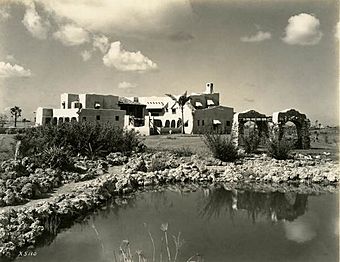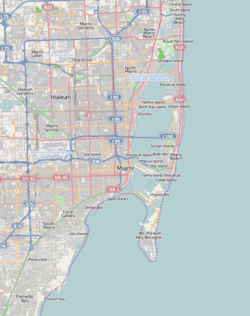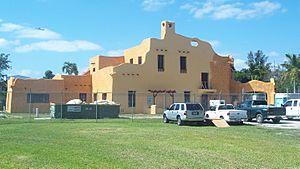Glenn Curtiss Mansion facts for kids
Quick facts for kids |
|
|
Glenn Curtiss House
|
|

View from the east, January 1927.
|
|
| Location | Miami Springs, Florida |
|---|---|
| MPS | Country Club Estates TR |
| NRHP reference No. | 85003579 |
| Added to NRHP | December 21, 2001 |
The Glenn H. Curtiss Mansion and Gardens is a special historic house located at 500 Deer Run in Miami Springs, Florida. Today, it is open to the public for events or private tours. You can find it right at the northern edge of Miami International Airport.
The Mansion's Story
This beautiful mansion was built in 1925. It was designed in the Pueblo Revival style, which looks like the traditional homes found in the American Southwest. The house was built by Glenn Hammond Curtiss, a famous person who helped create airplanes. He also helped develop several towns in Florida, including Hialeah, Opa-locka, Florida, and Miami Springs.
Glenn Curtiss lived in this large, two-story house with his wife, Lena Curtiss. They lived there until Glenn passed away in 1930. Lena Curtiss lovingly called the mansion "Dar-Err-Aha," which means "House of Happiness."
The Curtiss-Wright Company built many Pueblo-style homes in Miami Springs. The Curtiss Mansion was the biggest one in their Country Club Estates development. The house has a central outdoor area called a patio. This patio faces the golf course. The property was very large, covering more than 30 acres (about 120,000 square meters). It even had a small lake on one side. Glenn Curtiss brought many different kinds of water birds to the lake, like flamingos and swans.
After Glenn Curtiss died, Lena Curtiss married H. Sayre Wheeler. He was an old friend and business partner of her husband. The couple lived in the house until the late 1940s. The property was later sold in the mid-1950s and became a famous hotel called the Miami Springs Villas. In the late 1970s, it was sold again to Forte Hotels. Today, the city of Miami Springs owns the mansion.
Since 1998, the City of Miami Springs has owned the mansion. A group of volunteers formed Curtiss Mansion, Inc. This non-profit group works to restore and manage this important historic home. The mansion was named a Miami Springs historic site in 1987. It was then added to the National Register of Historic Places on December 21, 2001.
The Mansion's Unique Style
The architect who designed the mansion was Martin L. Hampton. He was one of Miami's most important architects in the 1920s. He also designed other famous buildings, like the old Miami Beach City Hall.
The Curtiss Mansion is shaped like a "V" if you look at it from above. It is built from hollow clay tiles and has a rough, textured outside made of stucco. The roof is flat, and its edges are uneven. These edges have cool water spouts and oddly shaped openings. The main entrance to the house is set back in a deep, T-shaped opening. A covered driveway, called a porte cochere, marks this entrance. Near the lake, there is a special outdoor area with a barbecue grill. This grill was built using a type of limestone called coral rock. This rock was leftover from when they dug the lake.
Saving the Mansion: A Big Project
Starting in the late 1970s, the house faced some tough times. It was damaged and had several fires. But in 1998, many groups came together to help save it. These included Curtiss Mansion, Inc. (CMI), the State of Florida, Miami-Dade County, and many other organizations and people who donated money.
After 17 years of hard work and raising millions of dollars, the mansion finally reopened to the public in 2012. Now, it is used for many different things. People can use it for historical events, cultural activities, educational programs, and community gatherings. Even though the City of Miami Springs owns the mansion, Curtiss Mansion, Inc. is in charge of raising money, keeping it maintained, and managing all its daily activities.
See also
 In Spanish: Casa Glenn Curtiss para niños
In Spanish: Casa Glenn Curtiss para niños





